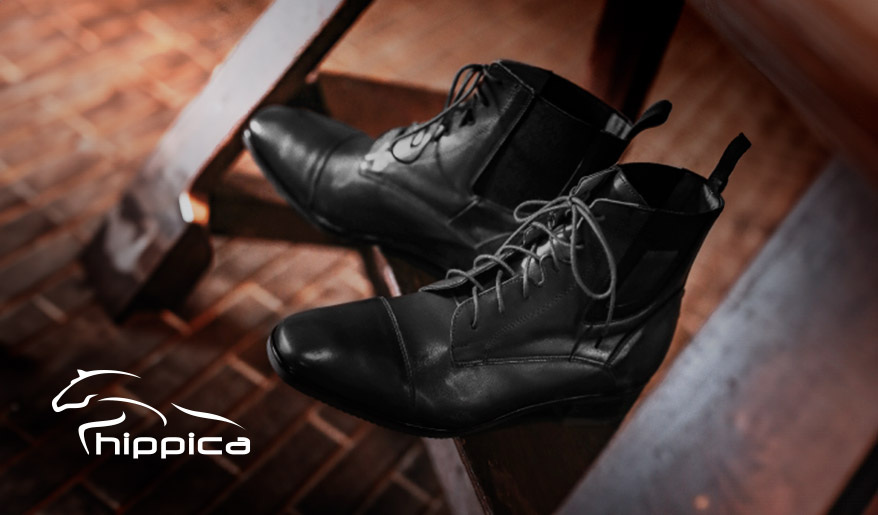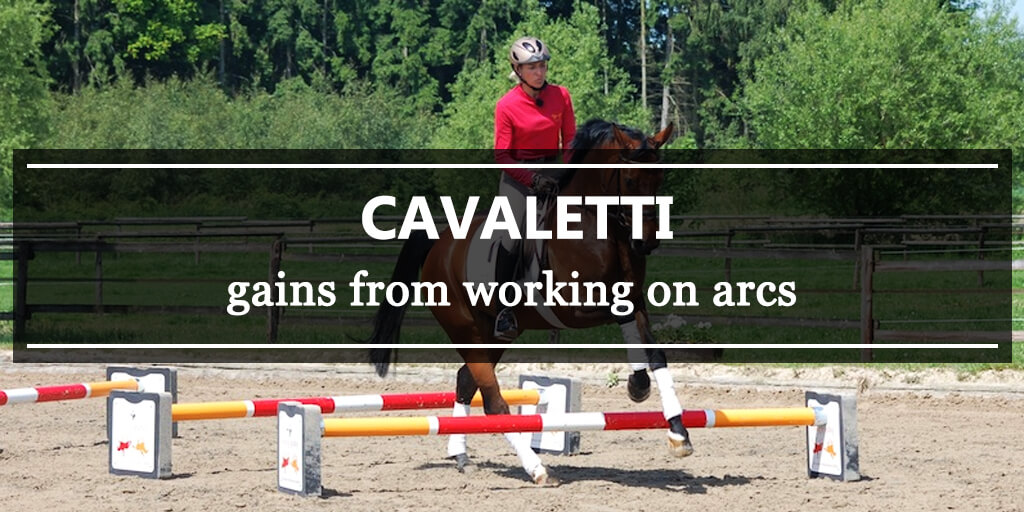
background source: pferdiathek.tv
We already wrote about work on cavaletti, what are its pros and cons and how to incorporate it into your daily rides. You also got to know how to conduct such training properly - with benefits for both the horse and rider.
We would like to dedicate this article solely for work with cavalettis on arcs. Below, we present to you the benefits from this type of exercise and exemplary arrangements adjusted to various gaits. Enjoy! :)
Pros of working on arcs
Due to work on arcs with the use of cavaletti - first of all, we diversify our training which help us achieve the desired concentration and full focus on the performed elements. The same will apply to the rider - especially the one who is still a beginner and there is a long way ahead to reach perfection. Instructors who do not allow monotony in their trainings and constantly set new goals for their trainees know that this speeds up the learning process and results in quicker progress.
Work on cavaletti on arcs will help us eliminate the one-sided stiffness and will improve elasticity of positioning of our steed during bending in both sides. Dressage riders, while working on arcs will achieve for example more fluent turns which will significantly improve quality of figures performed on the manage (volts, switchbacks, turns in corners or on the centre line etc.). Jumping riders will find it easier to conquer parkour because the horse becomes more "swivel" than means that he is able to round a bend more quickly. That will allow him to shorten the attempt, which is particularly important in speed competitions.
These poles also improve gait quality and its rhythm, as the horses have to engage their legs stronger, moving them above the poles and step them in even distance.
Working on straight lines ans arcs serves straightening the horse - that means that it leads to a state in which the horse's hinder hooves always move on the tracks of the front hooves. When you deal with a situation where your horse does not raise his hinder legs in the direction of centre of gravity but to the side - you can be sure that your horse is not straightened, unfortunately. What is important is that working on arcs help correct that.
Remember also that apart from straightening, the horse should always be placed to the inside on an arc. It is unacceptable for the horse's neck to be bend towards the outside of the arc, which results in the horse's head being outside the line. The same applies to the horse's croup and hinder legs - you cannot focus solely on the proper bend of his neck. By properly using your calves, you should be capable of bending the whole horse, which will prevent his croup from falling to the arc's outside and will make the horse go "straightened".
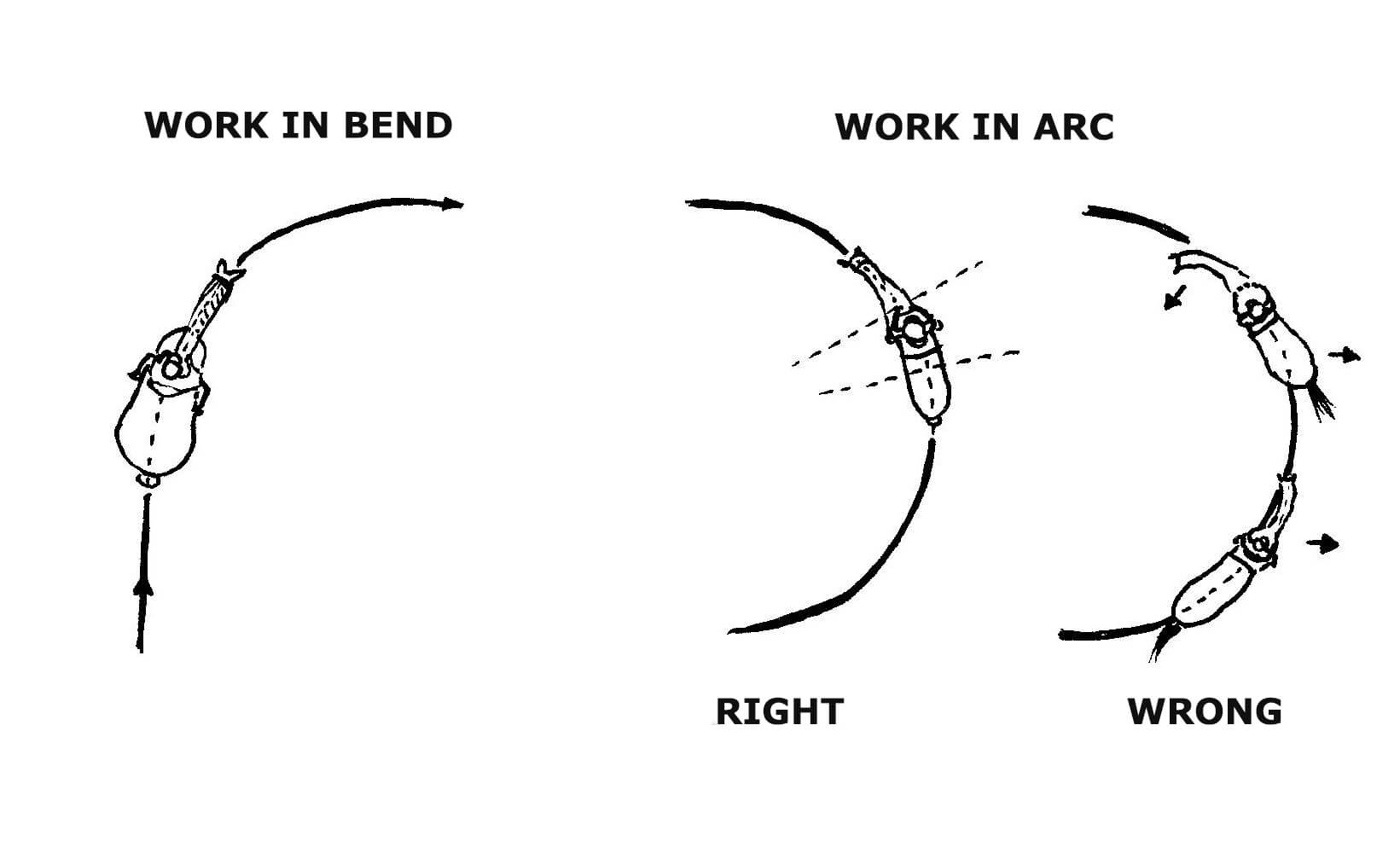
How to use aid in an arc or bend
We mentioned the "proper use of calves" - but what exactly does it mean? Below, we show you how you should properly use any aid you have while moving in an arc or bend.
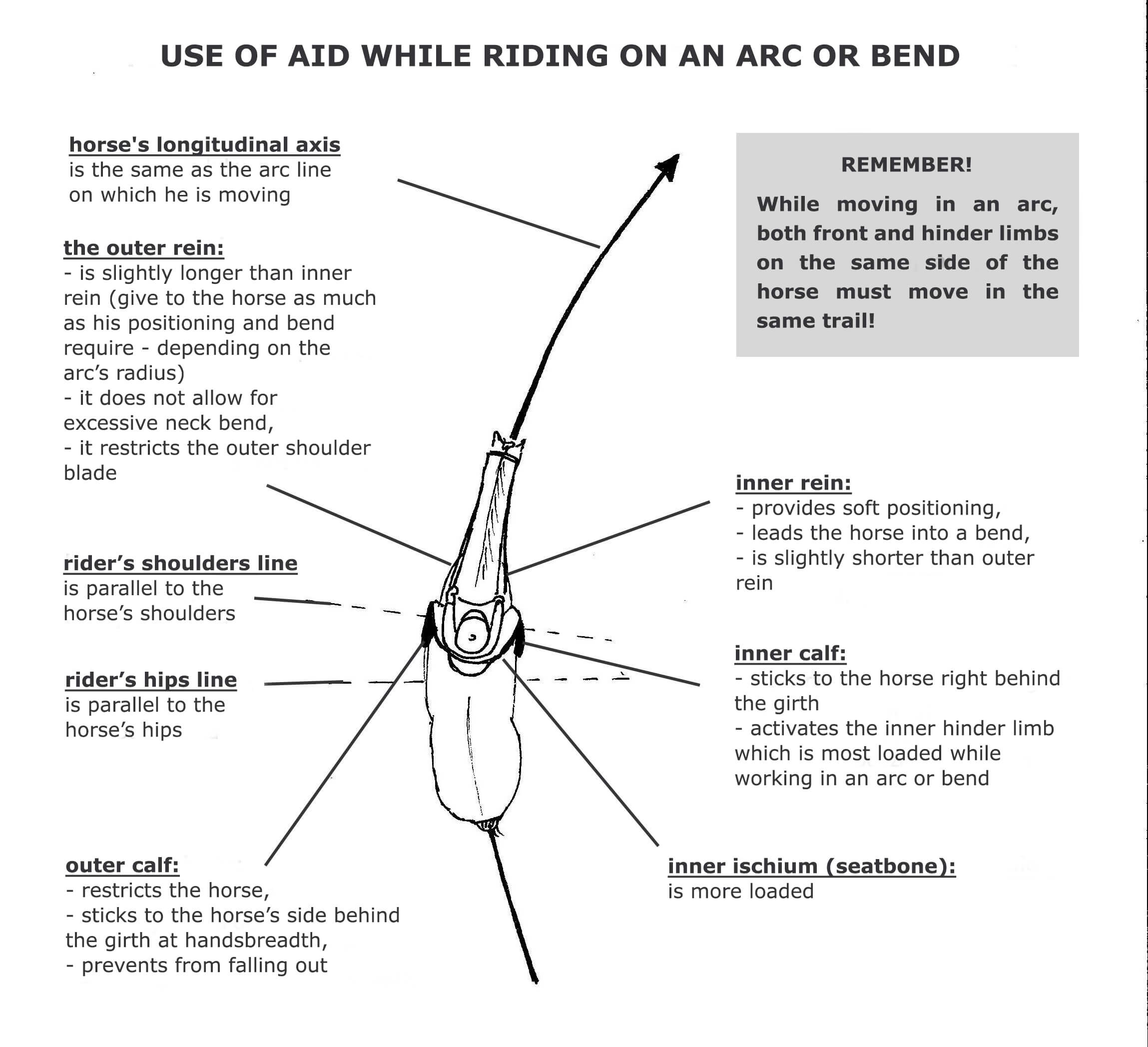
Thus, the horse should create one, half-round line - from his tail to his occiput. His body positioning thus should picture the trail in which he moves. The same rule applies while rounding a bend or turning.
Common mistakes while positioning on an arc
- too firm positioning that leads to the horse falling out with his outer shoulder blade of the arc - resulting with irregular gait of disrupted rhythm,
- positioning forced with the rider's stiff hand and too strongly pressed inner rein (from left: third example on the picture below) - precludes the horse from taking a step and engaging the inner hinder limb,
- reaching a hand too far front and giving the outer rein, but also tilting the horse's head by pressing the inner rein too strong (from left: second example on the picture below),
- bend in the occiput - blocking the positioning with the outer rein (lack of extension of this rein),
- lac of calves activity, the riders operates only with his or her reins - bending the horse only in his neck, which causes the horse to fall out of the arc with his croup,
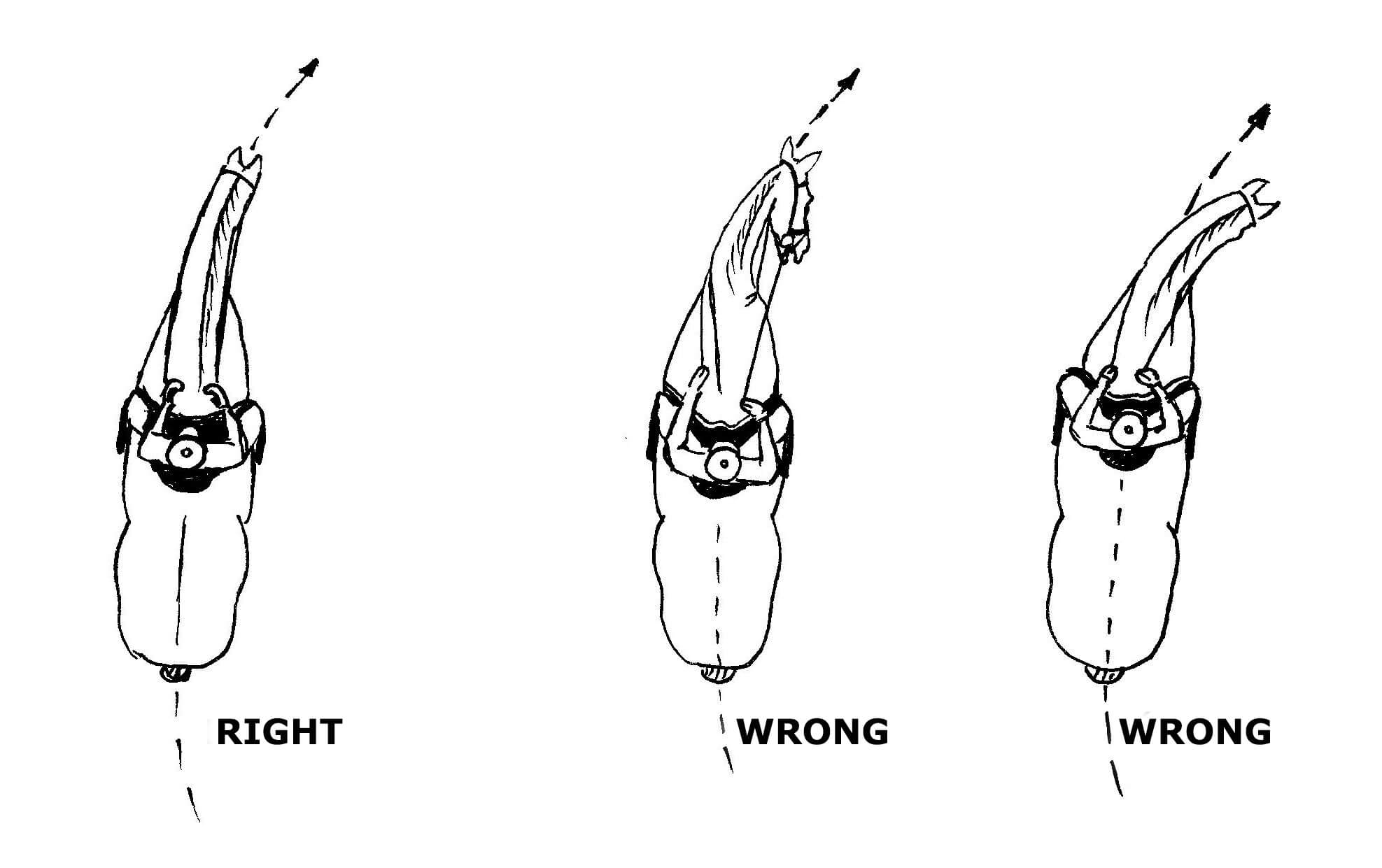
Figure of eight - change of direction
In a situation where you change direction (for example on a figure of eight), you should always straighten the steed on "one horse's length" so his body from the occiput to the tail was in a straight line. Then you should even the reins, centre your weight and work evenly with your calves, placed parallel on the horse's both sides. At the beginning of learning, the time of "one horse's length" might not be enough for you. In such case, you can extend it up to 3-4 lengths, and shorten it with time until you reach one length.
After the moment of straightening, you have to change the aid and position, adjusting to direction of the arc. Then you shift your body weight on a new - inner side, change you calves' position and correct the reins' length.
It is important to try to maintain elasticity and fluency of the movement during change of direction. In order to learn how to properly change direction, you can train in the arrangement presented below, which we already described in the article about warm-up.
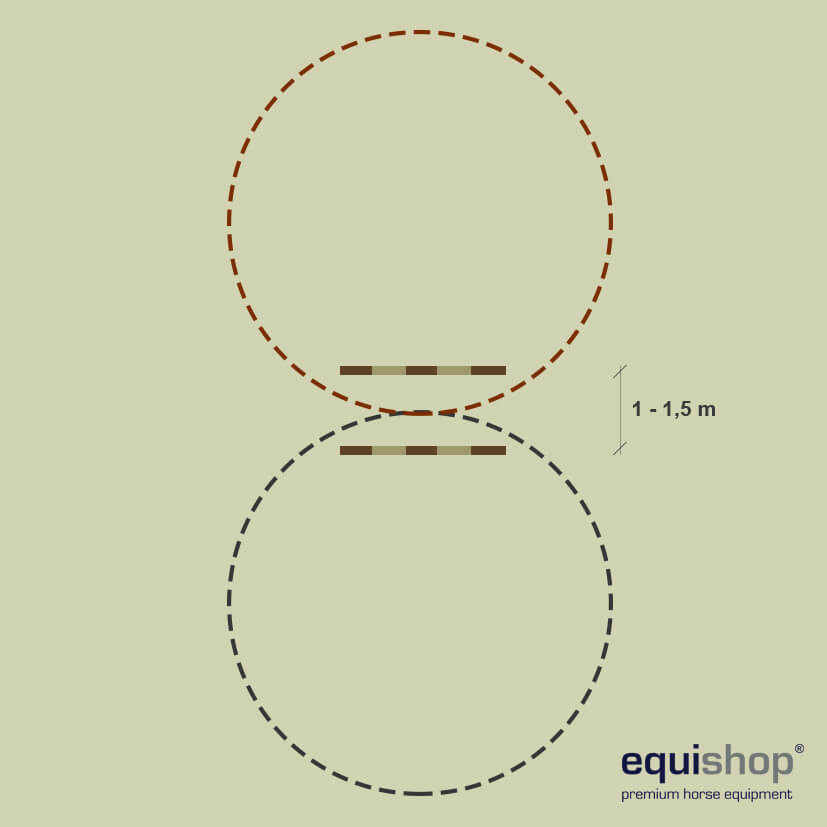
Perfect exercise to train fluent change of direction - straightening the horse happens while riding between two poles.
Work on arcs
Two types of exercise are recommended for working on arcs: in a circle and figure of eight.
It is good to start from exercises in a circle, as they are less demanding than figure of eight. Why? Because you work with the horse only in one side, not changing it during the exercise.
On horses with shorter steps you should approach the poles on the inner line of the circle, on which they are arranged. With time you can gradually lengthen their steps by riding on the outer line, at the same time extending the circle radius (like in working with a lunge).
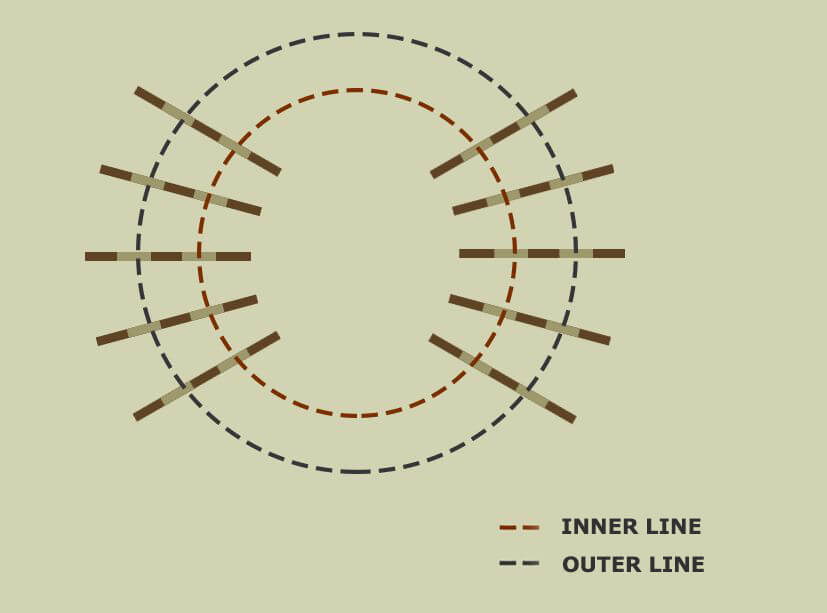
The most effective is work at trot and gallop - while you should spend more time at trotting. Work at walk has a lower training value and can turn out to be too hard at first - it is easier to properly position the horse in an arc at a faster gait. It can be felt while trying to ride through the middle of manage - perpendicularly from one short wall to the other. Then it becomes clear the it is the most difficult to keep a straight line at a walk.
That is why we describe working in an arc with cavaletti only at two gaits - trot and gallop.
Exemplary cavaletti arrangement
In a circle
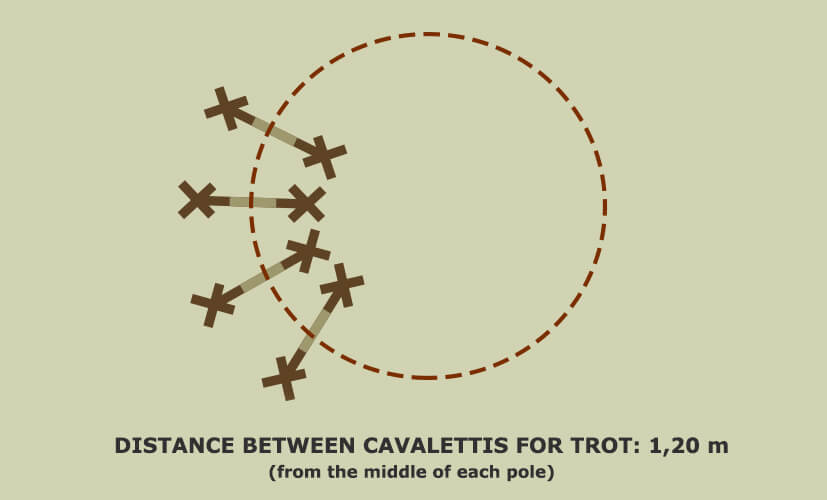
On the figure of eight
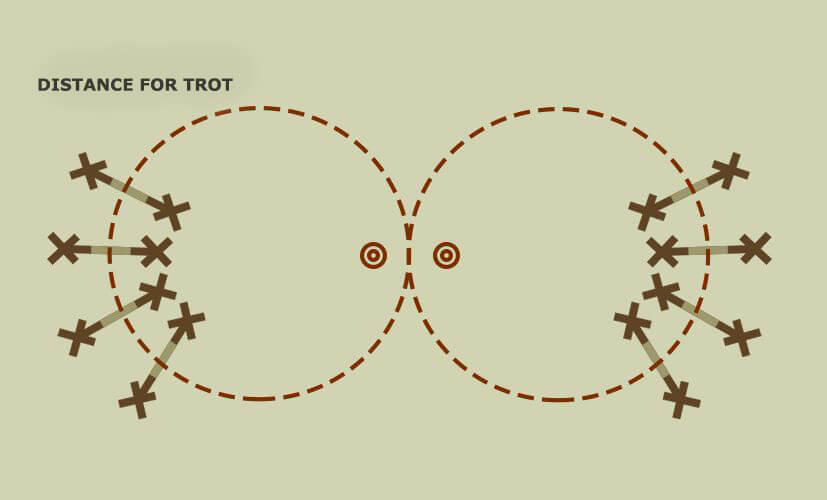
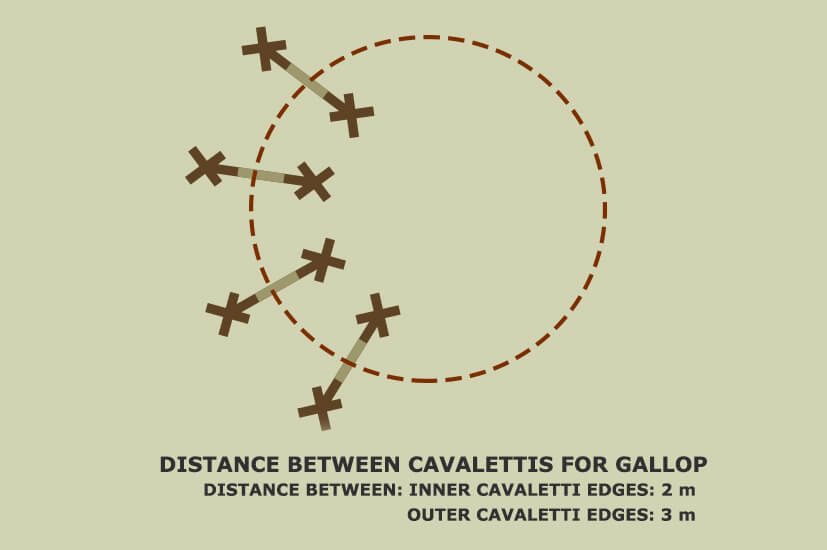
Note!
You have to remember that work on cavaletti on arcs is very gruelling, it especially loads the inner hinder leg. If you will train with your horse for too long or wrong - your steed might get an injury.
During training you should always bear in mind the rule "I properly adjust level of exercises to my horse's abilities". Omitting any stages of the horse's training or turning a blind eye to his shortages - will never pay off. These shortages, sooner or later, will surface and then it will turn out that we have to go back to the basics anyway.
Proper training on arcs with cavaletti
In theory, work on cavaletti can be planned for 2-3 days a week (if you train not less than 5-6 times a week). You can divide your training into three phases: warm-up (20 min), proper work (15-20 min) and finish (15-20 min).
Phase 1: warm-up
The aim of this phase is not only warming up, but also relaxing our horse's muscles in order to increase their elasticity and to prevent injuries.
We wrote in another article how important is and how a warm-up should look like - both for the horse and rider. In this phase, if you want to work in arcs, you should also consider a warm-up on poles and cavaletti, especially arranges in a straight line - riding in all three gaits (you should do it during the last minutes of this phase).
After the warming-up phase (finished with work on poles and cavaletti) you should make a short break (still moving in an energetic walk), during which cavaletti for work in arcs will get arranged - in circles and figures of eight.
When it comes to the cavaletti arrangement - you will find the right one for your horse with time. Above arrangement examples are just propositions. Preferably, the initial "right" distance for your steed will be the one measured between the middle of the poles. With time, you should try to ride out on the aforementioned outer line, at the same time extending the circle radius. What for? On the outer side, the distance is bigger, so the horse has to make longer steps and that engages his limbs more and develops his muscles. However, remember that the circle with cavaletti can be extended only a few times in each direction.
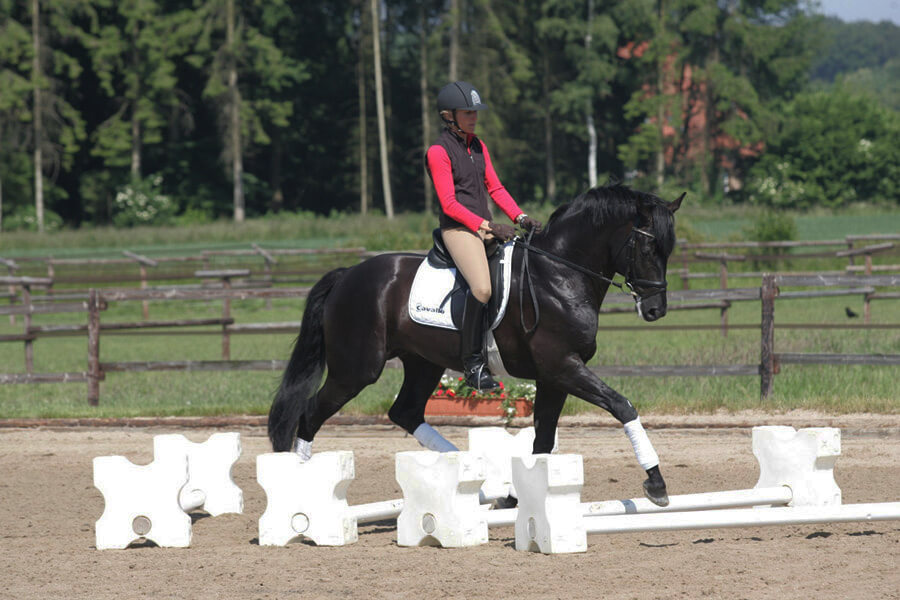
Rider working with cavaletti in full seat - Ingrid Klimke in the picture, source: paardenlifestyle.com
Phase 2: proper work in arcs
Work at a trot
During this part, you should remember about very simple words of Gustav Steinbrecht: "Ride your horse forward and set it straight." Thus, remember that the horse's body should create a single fluent like in an arc. Also try to ride energetically but do not allow your horse to hurry.
Start with posting trot. You can change to the training trot only when you horse can ride over the cavaletti in a posting trot without effort. We do not recommend full seat during the first type of training.
If you want to work on your poise - of course you can try to ride the obstacles in half-seat, but then you have to be aware that if would be harder to control the horse's body position. Thus, it is good to try the half-seat in some later trainings, when your horse will get how to ride in the arcs.
Remember to start the work in circles by riding in the "easier" side, that means the one in which the horse is more elastic and swivel. After some time change direction and ride in the "harder" side (more stiff), while it should take less time than riding in the "easier" side. From experience, change of direction every now and then (instead of riding mainly in the "harder" side) is beneficial for the stiff side, for the reason that the horse can forget about the problem for a while and become keen to work again.
After a couple of rounds on the arc, you should ride on a track along the manage's walls in order to bring the "freshness" and movement energy back, not allowing for monotony during training. Such "breaks" from cavaletti are very much recommended, especially for horses that tend to stiffen a lot.
If you feel ready, after work in a circle you can shift into work on a figure of eight, where you will perform change of horse's body position along with change of direction.
That may be obvious, but: you always start working at a trot, and then at a gallop (if you feel that your horse is ready for that).
After working at a trot you should take a short break between rides at a gallop.
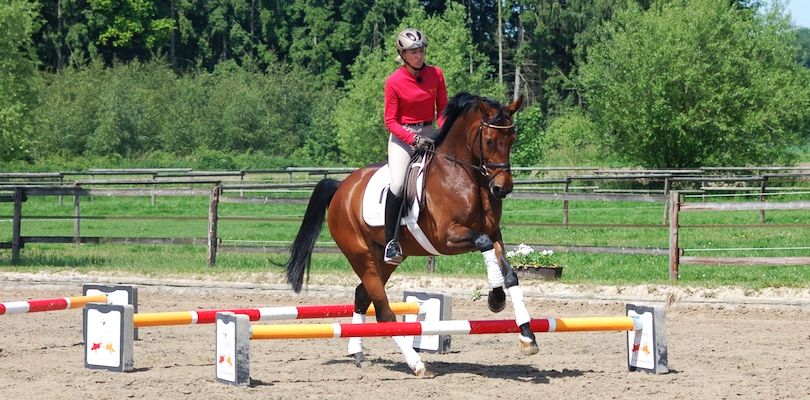
Riding cavaletti at a gallop, source: pferdiathek.tv
Work at a gallop
Work at a gallop in an arc exercises the horse and improves his bend at this gait. However, you should remember that the animal, while jumping over another poles will try to change his legs at a gallop - in order to prevent that you have to constantly maintain the proper position and bend of his body.
You can start from arranging one pole on the lowest level, adding another poles up to 4 in total. This exercise requires constant and prior planning of our track and looking at the next pole while you are jumping over the previous one. Besides, it forces you to mind the circle - riding over the middle of the poles. After a few properly performed rides on four poles, you can raise them.
At a gallop you can try various arrangements of the poles. However, you should always try not to allow your horse to run out and speed up during performing these exercises.
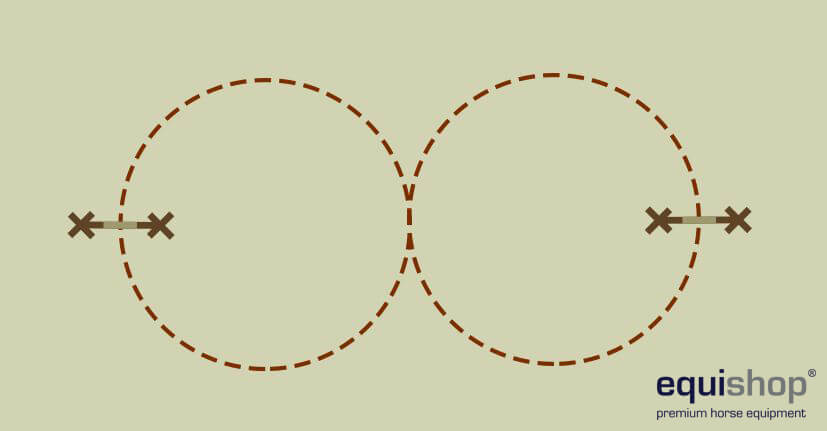
This exercise might be performed with a change of leg at a gallop or shift to a trot during change of direction.
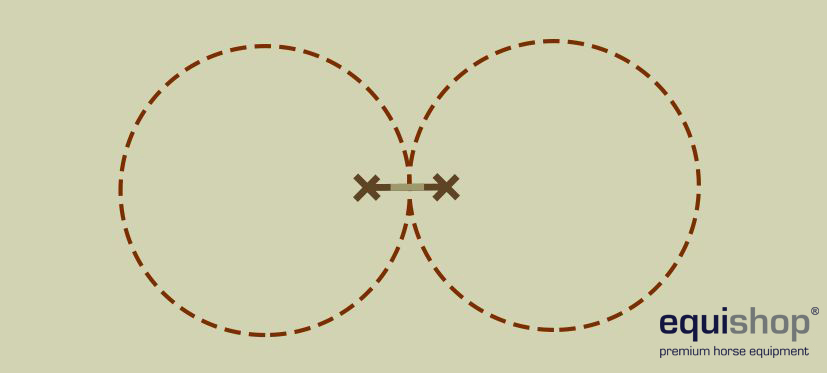
Cavaletti in the centre of the figure of eight.
The cavaletti in the centre of the figure of eight was placed in such a way the the horse might ride over it while changing directions. Such exercise is useful while learning how to change a leg at a gallop.
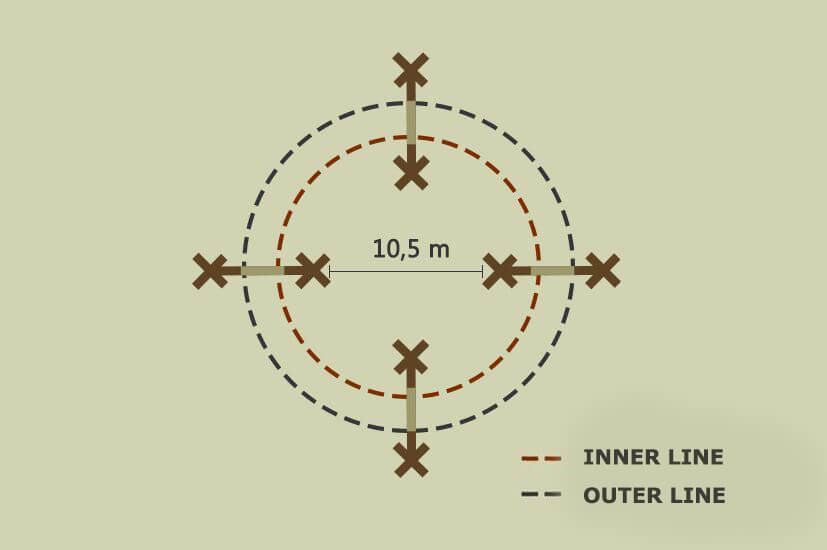
Four poles - inner line - poles at a 3 foules distance, outer line - 4 foules.
Another proposition is arranging four poles on the circle perimeter in even spaces. While performing this exercise, it is good to have a help from someone on the ground, who would be able to quickly adjust the poles, if for example the distance is not right, or when a pole gets knocked during a jump. This exercise will improve the rider's ability to plan another moves, because jumps over the poles happen quickly one after another. Larger spaces between the poles (3-4 foules) might cause the horse to lose the circle and rhythm - by speeding up. Thus, the rider has to take care for his horse to move at an even pace, using half halt. Maintaining even gallop is not easy, unfortunately. After a few laps you should take a break at a walk.
While performing the above exercise, start from approaching the middle of the poles. Initially, the rider should not pay attention to the number of foules between the poles nor to the proper place of jump - your horse will get there with time. After a few laps your horse should find the right rhythm. At the next stage, the rider may try to move on the inner or outer line - consciously leading the horse between the poles on 3 or 4 foules of a gallop.
This exercise is excellent for teaching your horse how to gallop elastically in bend, and the rider - feeling of the rhythm and distance.
Work with change of gait
If you can do both the circle and figure of eight, you can diversify it even more - circles and figures of eight with change of gait (picture below).
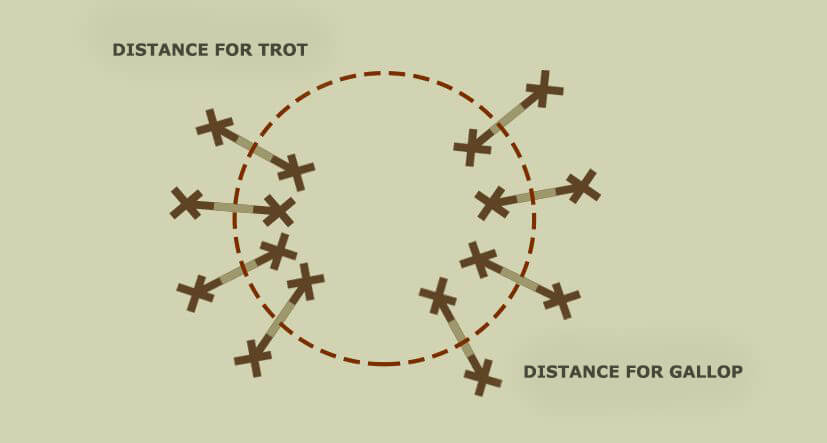
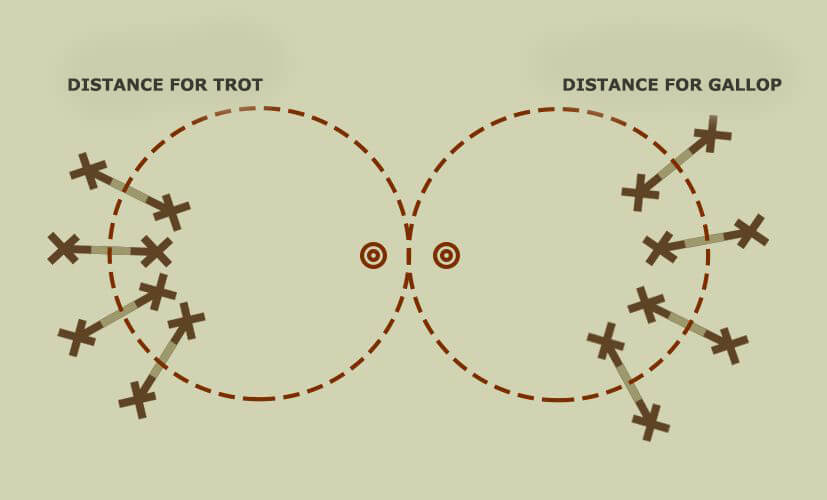
It is important that the proper work phase never lasts too long. If you can see that your horse is tired, you should immediately stop the exercise and move to another phase - finish.
Phase 3: finish
This phase is a gradual finish of your training. In this part, your aim should be to prepare your horse to come back to the stable - calming him down and relaxing. He should come back to his stall calm and content, so he can work even more willingly on the next training. This is why in the first part of this phase, you should perform 2-3 easy exercises which you are sure your horse will perform properly. Good finish of the training is half the battle!
After working on arcs, you can ride the poles again in a straight line a few times (as those aforementioned 2-3 easy exercises), gradually extending the rein and ending with "chewing from hand".
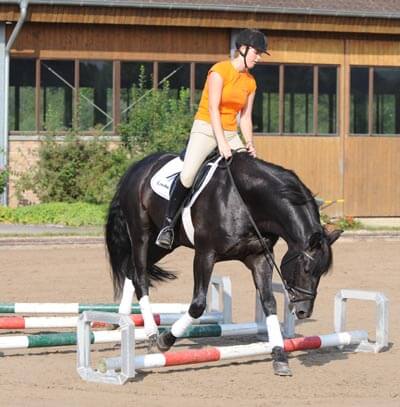
Extended rein on cavaletti makes the horse lower his head, at the same time relaxing his back muscles, source: horsemagazine.com
Next, depending on the training's intensity, you should provide your horse with 10-15 minutes of walk on a long rein.
We hope that our advice will prove useful and they will prompt you to diversify your daily training by incorporating exercises in arcs with the use of cavaletti :)












